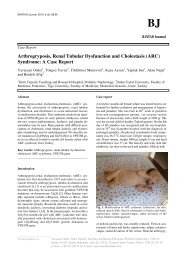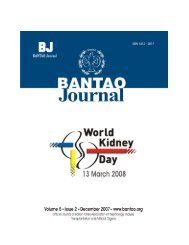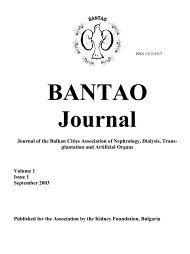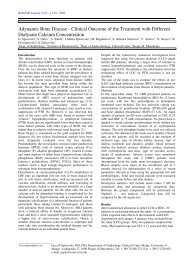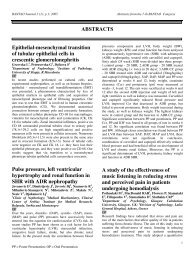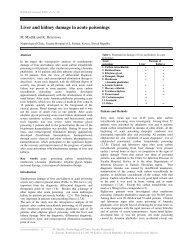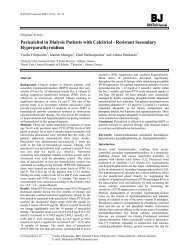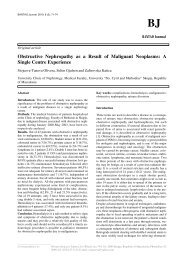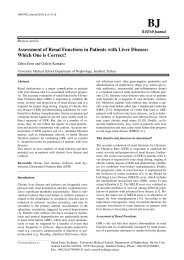Renal Transplantation in Croatia: A Personal View - BANTAO Journal
Renal Transplantation in Croatia: A Personal View - BANTAO Journal
Renal Transplantation in Croatia: A Personal View - BANTAO Journal
You also want an ePaper? Increase the reach of your titles
YUMPU automatically turns print PDFs into web optimized ePapers that Google loves.
<strong>BANTAO</strong> <strong>Journal</strong> 2010; 8 (2): 51-53<br />
BJ<br />
<strong>BANTAO</strong> <strong>Journal</strong><br />
Editorial comment<br />
<strong>Renal</strong> <strong>Transplantation</strong> <strong>in</strong> <strong>Croatia</strong>: A <strong>Personal</strong> <strong>View</strong><br />
Basic-Jukic Nikol<strong>in</strong>a i Kes Petar<br />
Department of nephrology and dialysis, Cl<strong>in</strong>ical Hospital Centre Zagreb, University of Zagreb, Zagreb,<br />
<strong>Croatia</strong><br />
History of renal transplantation <strong>in</strong> <strong>Croatia</strong><br />
<strong>Renal</strong> transplantation <strong>in</strong> <strong>Croatia</strong> has a long history. First<br />
transplantation from the liv<strong>in</strong>g donor was performed <strong>in</strong> Rijeka<br />
<strong>in</strong> 1971 by Professor V<strong>in</strong>ko Franciskovic. Next year,<br />
first renal transplantation from deceased donor was also<br />
performed <strong>in</strong> Rijeka. University hospital centre Zagreb started<br />
with renal transplantation <strong>in</strong> 1972. First comb<strong>in</strong>ed kidney-pancreas<br />
transplantation was performed <strong>in</strong> Rijeka <strong>in</strong><br />
1993, while the first kidney-liver comb<strong>in</strong>ed transplantation<br />
was done <strong>in</strong> University hospital Merkur <strong>in</strong> Zagreb <strong>in</strong> 2005.<br />
Patients on renal replacement therapy <strong>in</strong> <strong>Croatia</strong><br />
Accord<strong>in</strong>g to the data from <strong>Croatia</strong>n registry for renal<br />
replacement therapy 4009 patients had been treated with<br />
renal replacement therapy on December 31 st 2008. Out<br />
of this number (prevalence of 904 per million population),<br />
68% were treated with hemodialysis, 6% with peritoneal<br />
dialysis and 26% of patients had function<strong>in</strong>g renal<br />
allograft. The most common primary renal disease was<br />
diabetic nephropathy (31%), followed by vascular diseases<br />
(22%) and glomerulonephritis (15%) [1].<br />
<strong>Transplantation</strong> centers<br />
There are currently 4 renal transplantation centers <strong>in</strong> <strong>Croatia</strong>:<br />
two <strong>in</strong> Zagreb (University hospital centre Zagreb and Cl<strong>in</strong>ical<br />
hospital Merkur), one <strong>in</strong> Rijeka and Osijek. Tissue<br />
typ<strong>in</strong>g centers are situated <strong>in</strong> Zagreb, Rijeka and Split.<br />
Establishment of renal transplant program<br />
Significant efforts were needed to establish a successful<br />
renal transplant program. A well tra<strong>in</strong>ed and experienced<br />
personnel was already available, but as all surroundd<strong>in</strong>g<br />
countries, <strong>Croatia</strong> suffered from lack of donors. In 2003<br />
M<strong>in</strong>istry of health of Republic of <strong>Croatia</strong> recognized the<br />
importance of renal transplantation for the benefit of patients<br />
but also of the whole society and started with strong<br />
support for organ donation. Previous isolated efforts<br />
(donor network, donor cards, renal transplant personnel<br />
efforts...) get additional strength. Promotion <strong>in</strong> different<br />
media like television and magaz<strong>in</strong>es, series of lectures held<br />
for medical doctors resulted <strong>in</strong> <strong>in</strong>creas<strong>in</strong>g number of donors.<br />
It is well known that positive stories <strong>in</strong> media result<br />
<strong>in</strong> <strong>in</strong>crease of organ donation, and <strong>Croatia</strong> succeeded to<br />
avoid any possibility of wrong <strong>in</strong>terpretation of organ allocation.<br />
All decisions were brought by a team consisted of a<br />
nephrologist, transplant surgeon and immunologist. Organ<br />
allocation was primarily based on HLA match<strong>in</strong>g.<br />
One of the most important measures <strong>in</strong> favor of transplantation<br />
occurs when M<strong>in</strong>istry of health decided to f<strong>in</strong>ancially<br />
cover renal transplantation separately from the<br />
usual hospital limits. These measures enable <strong>in</strong>troducetion<br />
of novel immunosuppressive drugs and protocols <strong>in</strong><br />
renal transplantation, as well as performance of immunologically<br />
„high risk“ transplantations which need more<br />
<strong>in</strong>tensive and thus more expensive immunosuppressive<br />
treatment.<br />
From the po<strong>in</strong>t of organ donation, very important measure<br />
was <strong>in</strong>troduction of national and hospital coord<strong>in</strong>ators<br />
for organ donation who are responsible for identifycation<br />
and further process<strong>in</strong>g of potential donors. Larger<br />
hospitals have dedicated transplant coord<strong>in</strong>ators, while <strong>in</strong><br />
smaller hospitals this function is usually performed by<br />
<strong>in</strong>tensivists or anestesiologists. It is <strong>in</strong>terest<strong>in</strong>g that the second<br />
most active hospital is small general hospital <strong>in</strong> Varažd<strong>in</strong>,<br />
city on the north of <strong>Croatia</strong>. This situation clearly<br />
demonstrates the importance of the so called „human<br />
factor“ <strong>in</strong> success of any process.<br />
Cl<strong>in</strong>ical coord<strong>in</strong>ators for renal transplantation work <strong>in</strong> renal<br />
transplant centers and are responsible for the ma<strong>in</strong>tenance<br />
of the wait<strong>in</strong>g-list and for cooperation with Eurotransplant.<br />
They coord<strong>in</strong>ate evaluation before wait-list<strong>in</strong>g and<br />
reevaluations of the patients dur<strong>in</strong>g their wait<strong>in</strong>g for renal<br />
transplantation. These are nephrologists who work<br />
<strong>in</strong> close collaboration with transplant surgeons.<br />
Based on the previous actions <strong>Croatia</strong> succeeded to establish<br />
a solid renal transplant program and to <strong>in</strong>crease number<br />
of donors, thus becom<strong>in</strong>g <strong>in</strong>terest<strong>in</strong>g for other countries<br />
<strong>in</strong> the region for organ exchange. Eurotransplant is<br />
organization for organ allocation which allocates organs<br />
<strong>in</strong> 7 different European countries. <strong>Croatia</strong> jo<strong>in</strong>ed Eurotransplant<br />
<strong>in</strong> June 2007, and from August 15th 2007 first organs<br />
were transplanted via this organization.<br />
________________________<br />
Correspondence to: Nikol<strong>in</strong>a Basic-Jukic, Department of nephrology and dialysis, University hospital centre Zagreb,<br />
Kispaticeva 12, 10000 Zagreb, <strong>Croatia</strong>; Phone/Fax: +385-1-2312-517; E-mail: n<strong>in</strong>a_basic@net.hr
52<br />
<strong>Renal</strong> transplantation <strong>in</strong> <strong>Croatia</strong><br />
From that po<strong>in</strong>t of time significant changes have occurred.<br />
First of all, a str<strong>in</strong>gent adm<strong>in</strong>istrative support was necessary<br />
to ma<strong>in</strong>ta<strong>in</strong> the whole structure, start<strong>in</strong>g from the<br />
M<strong>in</strong>istry of health with a national coord<strong>in</strong>ator, across the<br />
hospital coord<strong>in</strong>ators, cl<strong>in</strong>ical coord<strong>in</strong>ators, f<strong>in</strong>ish<strong>in</strong>g with<br />
doctors work<strong>in</strong>g <strong>in</strong> dialysis centers, and f<strong>in</strong>ally with a renal<br />
transplant recipient. Thus, excellent organization available<br />
24 hours per day was necessary for this project. Once<br />
when this organizational scheme was established, everyday<br />
work becomes much easier than before.<br />
Second, a significant change <strong>in</strong> organ allocation was implemented.<br />
From the HLA based organ allocation we swit-<br />
ched to Eurotransplants' scheme of allocation which counts<br />
wait<strong>in</strong>g time, HLA match<strong>in</strong>g and country balance<br />
(export and import of organs between the countries). This<br />
allocation scheme resulted <strong>in</strong> high number of renal transplantations<br />
be<strong>in</strong>g performed <strong>in</strong> the long-term dialysis patients<br />
who ga<strong>in</strong>ed lots of po<strong>in</strong>ts for the wait<strong>in</strong>g-time. Dur<strong>in</strong>g<br />
the first three days <strong>in</strong> Eurotransplant, 9 transplantations<br />
were performed just <strong>in</strong> Cl<strong>in</strong>ical Hospital Centre Zagreb.<br />
Statistics<br />
Based on <strong>in</strong>creased organ donation (Figure 1), from 1998<br />
to 2008, significant <strong>in</strong>crease <strong>in</strong> number of renal transplan-<br />
No of donors<br />
90<br />
80<br />
70<br />
60<br />
50<br />
40<br />
30<br />
20<br />
10<br />
0<br />
1998 1999 2000 2001 2002 2003 2004 2005 2006 2007 2008<br />
year<br />
Fig. 1. Number of deceased donors from 1998 to 2008<br />
160<br />
140<br />
120<br />
100<br />
80<br />
60<br />
40<br />
20<br />
0<br />
1998 1999 2000 2001 2002 2003 2004 2005 2006 2007 2008<br />
year<br />
Fig. 2. Number of renal transplantations <strong>in</strong> <strong>Croatia</strong> from 1998 to 2008<br />
tations was recorded (Figure 2). Number of liv<strong>in</strong>g donors<br />
ranged from 7 to 24 per year (11-28 % of all transplantations),<br />
what demonstrates that there is still possibility<br />
to <strong>in</strong>crease number of renal transplantations <strong>in</strong> <strong>Croatia</strong> by<br />
promotion of liv<strong>in</strong>g organ donation. In 2009, University hospital<br />
centre Zagreb performed 105 renal transplantations thus<br />
becom<strong>in</strong>g the 6 th biggest centre <strong>in</strong> Eurotransplant.<br />
Chang<strong>in</strong>g trend <strong>in</strong> characteristics of renal allograft<br />
recipients<br />
First year <strong>in</strong> Eurotransplant was characterized by renal<br />
transplantations performed <strong>in</strong> very long-term dialysis pati-<br />
Table 1. Chang<strong>in</strong>g trend <strong>in</strong> characteristics of renal allograft<br />
recipients. HBV – hepatitis B, HCV – hepatitis C<br />
2007 2008 2009<br />
HBV + 0 2(2.19%) 0<br />
HCV + 8(20.5%) 17(18.68%) 2(2.7%)<br />
Age 48 47 48<br />
Years on dialysis 12 8 6<br />
Second<br />
transplantation<br />
0 6 7
N. Basic-Jukic et al. 53<br />
ents (Table 1). High proportions of patients were hepatitis<br />
C or B positive. In the succeed<strong>in</strong>g years, “normalization”<br />
of renal transplantation had occurred, while most of<br />
the long-term dialysis patients received kidney allograft<br />
dur<strong>in</strong>g the first year.<br />
Conclusion<br />
Pathway for establishment of deceased donor renal transplant<br />
program is hard with <strong>in</strong>clusion of all society.<br />
Promotion of organ donation, transparency of allocation,<br />
devotion of transplant stuff and f<strong>in</strong>ancial support are all<br />
necessary for successful transplantation.<br />
Conflict of <strong>in</strong>terest statement. None declared.<br />
References<br />
1. <strong>Croatia</strong>n registry for renal replacement therapy. Annual<br />
report. Available at: http://www.hdndt.org/registar-forward-<br />
2005.htm. Approached on January 27, 2010.



